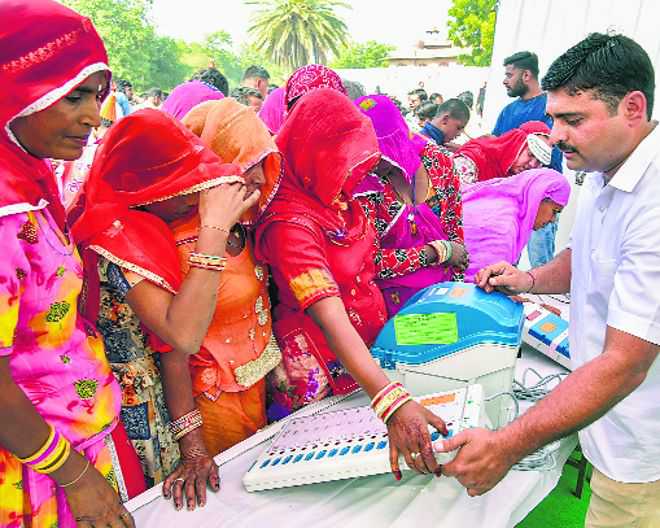Atanu Biswas
Professor, Indian Statistical Institute, Kolkata
A ballot paper with a black cross across it — that’s the symbol of the last option in an EVM. In September 2013, the Supreme Court upheld the right of voters to reject all candidates contesting the elections, saying that it would go a long way in cleansing the political system. The Bench headed by then Chief Justice of India P Sathasivam observed, “Negative voting will lead to a systemic change in the polls and political parties will be forced to project clean candidates. If the right to vote is a statutory right, then the right to reject a candidate is a fundamental right of speech and expression under the Constitution.”
Countries like Colombia, Ukraine, Brazil, Bangladesh, Finland, Spain, Sweden, Chile, France, Belgium and Greece allow their voters to cast NOTA (none of the above) votes. In India, the NOTA option was first used in the Assembly elections held in five states in 2013, and got less than 1.5 per cent of the total votes. In India, NOTA’s share remained in the 1-2 per cent range, even less in some cases. NOTA got 2.48 per cent votes in Bihar and 0.4 per cent in Delhi, both in 2015. Still, NOTA was exercised by about 60 lakh people in the Lok Sabha elections in 2014.
The NOTA option on EVMs has no electoral value. Even if NOTA gets the maximum number of votes polled, the candidate getting the most of the remaining votes would be declared the winner. There are discussions about the distribution of NOTA votes according to the socio-economic variations. People are concerned about the number of constituencies where NOTA votes are more than the margin of victory. The percentage of such constituencies is 8-10 per cent across the country. NOTA got more votes than the victory margin from 22 seats in the Madhya Pradesh Assembly elections in 2018; 30 seats in the Gujarat elections (2017); 25 seats in Tamil Nadu (2016); and 23 constituencies in West Bengal (2016). But if the NOTA option was unavailable, some of those who voted for NOTA could have abstained from voting, and other votes could have been distributed among different contestants. Sometimes, opting for NOTA in a group has become a means to register protest for some reason.
Is the enthusiasm over NOTA intact, or is it increasing or decreasing? We need results from multiple elections from the same state or multiple Lok Sabha polls. NOTA was introduced in late 2013, and except for a few states, most of them had only one Assembly election in between, data on which is insufficient to draw any inference on the possible change in popularity of NOTA. The 2014 Lok Sabha polls was the only General Election in this period. Among the exceptions where two Assembly elections took place in between, we consider three — Delhi, Madhya Pradesh and Mizoram. Delhi is possibly the first state to give an indication of the waning popularity of NOTA through its Assembly elections in 2013 and 2015. Madhya Pradesh and Mizoram had two elections — in late 2013 and late 2018.
We find strong positive correlation between the NOTA vote percentages in two successive elections in each state, which indicates that the constituencies which recorded larger/ smaller NOTA votes in the first election had also larger/smaller NOTA votes in the second election, on an average. The values of these correlation coefficients are 0.43 (Delhi), 0.81 (Madhya Pradesh) and 0.53 (Mizoram). The correlation coefficient is a measure of linear association between two variables, and a value of correlation coefficient around 0.5 indicates fairly high positive correlation.
Analysing the data from these states in the two elections, we get a common pattern. The proportion of NOTA votes is decreasing, on an average, in these states. In Delhi, about 96 per cent of the constituencies had a smaller percentage of NOTA votes in 2015 than that in 2013, whereas in MP and Mizoram about 86 per cent and 85 per cent of the seats, respectively, experienced lesser NOTA support in 2018 than in 2013. The average percentage of NOTA votes per constituency was 0.64 per cent (2013) and 0.4 per cent (2015) in Delhi, 1.87 per cent (2013) and 1.40 per cent (2015) in MP, and 0.66 per cent (2013) and 0.44 per cent (2018) in Mizoram.
We may conclude that NOTA might be losing its popularity as far as the Assembly election data on Delhi, Madhya Pradesh and Mizoram is concerned. Of course, we need data from other states and Lok Sabha elections as well for a more concrete conclusion, which can be available within 3-4 years.
Will the percentage of NOTA votes be changed if NOTA becomes NOTB (none of the below, where this option will come first on the EVM) or NOTC (none of the candidates, where this option will be placed randomly on the EVM as the other candidates are randomly ordered)? This might be an interesting social and behavioural experiment.
Unlock Exclusive Insights with The Tribune Premium
Take your experience further with Premium access.
Thought-provoking Opinions, Expert Analysis, In-depth Insights and other Member Only Benefits
Already a Member? Sign In Now










